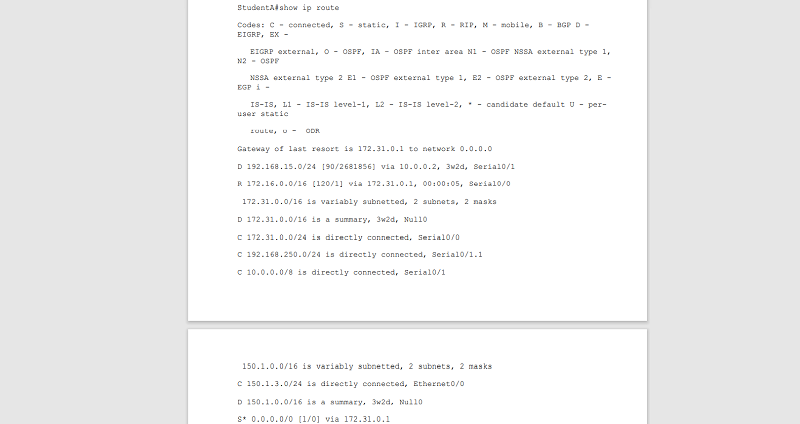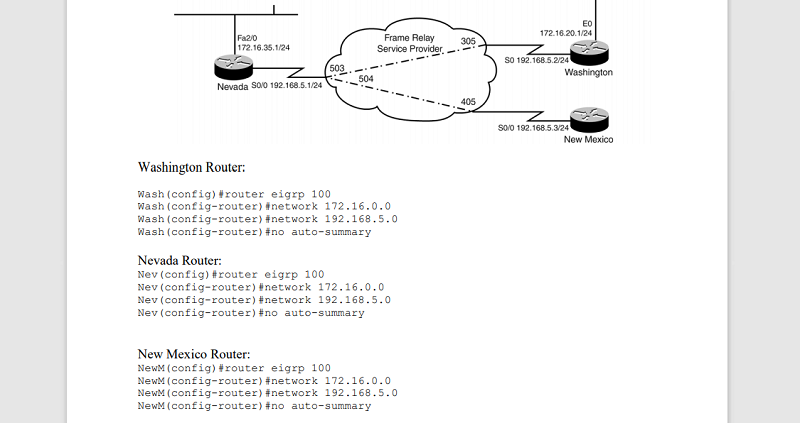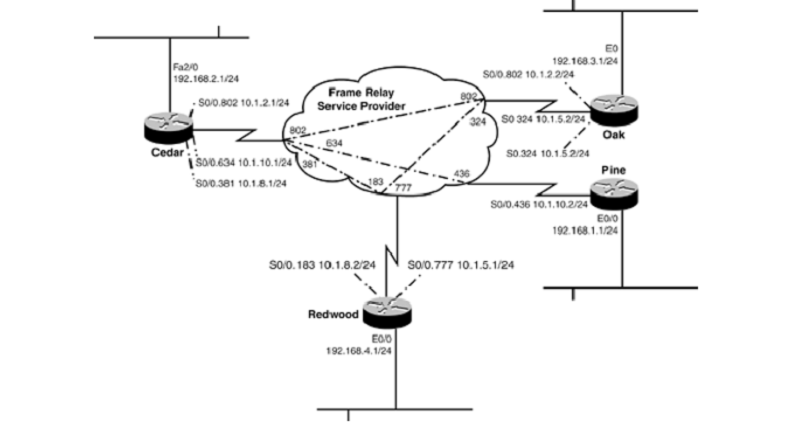Routing

Mastering Routing Protocols Quiz
Test your knowledge of routing protocols with this comprehensive quiz designed for networking enthusiasts and professionals. With 50 challenging questions, this quiz covers a wide range of topics, including OSPF, RIP, IGRP, and EIGRP.
Whether you're preparing for certification, enhancing your skills, or simply testing your knowledge, you'll find questions that will engage and educate you. Dive in and challenge yourself!
- 50 questions on routing protocols
- Multiple-choice and checkbox formats
- Immediate feedback on your answers
You are setting up OSPF on your network and your junior administrator asks you about the router ID. She wants to know what sets the router ID for OSPF on your router. Your network is made up of ten 2611 routers with two serial, two Ethernet, and two loopback interfaces. What do you tell her?
It's the lowest IP address on your physical interfaces.
It's the highest IP address on your physical interfaces.
It's the highest IP address on your logical interfaces.
It's the lowest IP address on your logical interfaces.
It's the lowest IP address on any interface, physical or logical.
Your boss asks you to explain the difference between a routed protocol and a routing protocol. Which of the following statements best describe the difference? (Choose two.)
Routed protocols cannot cross routers.
Routing protocols can identify data.
Routed protocols help transport data between network segments.
Routing protocols are used by routers to communicate routing information.
You have placed a static route on your router to get to Network A. You also have RIPv1 and OSPF running on your router. The router receives updates from RIP and OSPF on how to get to Network A. Which of the routes does the router use to get to Network A?
The static route
The RIP route
The OSPF route
None of the above, as they will cancel each other out

You issue the following command: What is the meaning of the [90/2681856] in the output following the command?
It's the port number and hop count of the RIP routing protocol.
It's the administrative distance and hop count of the EIGRP routing protocol.
It's the port number and metric of the EIGRP routing protocol.
It's the administrative distance and metric of the route learned through EIGRP.
On an OSPF router, you use the following command in Router Configuration mode for OSPF: network 0.0.0.0 255.255.255.255 area 0 What is the effect of this command?
This command instructs OSPF to send an update to Area 0.
This command configures the OSPF router with a router ID.
This command includes all the connected interfaces and networks in the OSPF routing process.
This command is invalid and is not accepted.
Which of the following is a link-state protocol that uses a complex database to choose the best route for each network?
RIP
OSPF
IGRP
BGP
Which of the following commands enable IGRP routing on the ExamCram 4 router? (Choose three.)
ExamCram4(config)#router igrp
ExamCram4(config)#router igrp 100
ExamCram4(config-router)#network 192.168.0.0
ExamCram4(config-router)#network 192.168.2.0
ExamCram4(config-router)#network all
ExamCram4(config-router)#network 192.168.3.0
When dealing with distance-vector routing protocols, you encounter the term split-horizon. Which of the following statements describes this feature?
It allows routers to split up networks.
All distance-vector protocols require fallback routers that might cause momentary loops as the topology changes.
Convergence is achieved if all information about routers is sent out on all active interfaces.
Information about a route should not be sent back in the direction from which the original update came.
You are using RIP as your routing protocol. Your WAN service provider asks you to use the passiveinterface command for the serial interface that is attached to the service provider. What does this command accomplish?
It puts the interface in shutdown.
It tells a router to send routing updates out the interface but not to listen to any routing updates.
It allows an interface to remain up despite the fact that the service provider does not provide keepalives.
It tells a router to receive routing updates on an interface but not to send updates via that interface.
You need to configure a static route to reach the 10.20.0.0 network. Which of the following is an example of the correct syntax you should use?
Ip route 10.20.0.0 255.255.0.0 10.10.0.1
Ip route 10.20.0.0 0.0.255.255 10.10.0.1
Route 10.20.0.0 255.255.0.0 serial 0 100
Route 10.20.0.0 255.255.0.0 10.10.0.1
What class of routing protocol combines aspects of the link-state and distance-vector algorithms?
Mix
Hybrid
Link-distance
Distance-link
Which of the following routing protocols has a default administrative distance of 120 on Cisco routers?
RIP
IGRP
OSPF
EIGRP
When a router sets the metric for a network that has gone down to the maximum value, what is it doing?
Applying split-horizon
Putting the route in hold-down
Poisoning the route
Sending a triggered update
Which of these statements is true regarding distance-vector routing protocols?
They send the entire routing table to directly connected neighbors.
They send the entire routing table to every router in the network.
They send the changes to the routing table to directly connected neighbors.
They send the changes to the routing table to every router in the network.
To prevent routing loops, distance-vector routing protocols use a maximum metric. What is the maximum reachable metric for RIP?
10
15
16
60
100
255
What routing loop solution prevents a router from sending information back to the neighbor that originally sent the information?
Split-horizon
Hold-down timer
Maximum hop count
Route poisoning
Counting to infinity
After typing the command show ip route, you see a list of IP addresses with [120/8] next to them. What does the [120/8] mean?
Cost/Metric
Administrative Distance/Metric
Metric/Distance
Cost/Hop Count
You type show ip route on Router A to find ou the following routes would not be found on a separate router receiving an RIP update from Router A?
R 172.16.0.0/16 [120/4]
R 192.168.9.0/24 [120/2]
C 192.168.4.0/24
R 192.168.7.0/24 [120/1]
R 192.168.8.0/24 [120/8]

You have configured the routers shown in the figure below using the EIGRP protocol. The relevant configuration is as follows: Routers using EIGRP Protocol. Users in Washington and New Mexico are complaining about connectivity issues; however, users in Nevada seem to be working just fine. What is the most likely cause of the problem?
The EIGRP protocol is not to be used on frame relay networks. Cisco recommends using either OSPF or RIP industry standard protocols in this style of configuration.
Because EIGRP is technically categorized as a distance horizon causes problems in this configuration.
The EIGRP autonomous system 100 is reserved for loopback routing protocol communication
The no auto-summary command causes routing issues in this environment because the configuration is using class C subnet masks for the 172.16.0.0 network.
Your boss tells you that he read about the RIP routing protocol and found out that it uses hop count for its metric. He wants to know what the default metric used by IGRP is. What do you tell him?
Bandwidth and delay
Hop count
Ticks
Bandwidth

You are configuring the Ike router on the network shown in the figure below. You would like to use the RIP routing protocol to propagate all the networks to the three routers shown. What configuration would you apply to Ike to have it participate in this objective?
Ike(config)#router rip Ike(config-router)#network 172.16.0.0 Ike(config-router)#network 192.168.45.0
Ike(config)#router rip Ike(config-router)#network 172.16.30.0 Ike(config-router)#network 192.168.35.0 Ike(config-router)#network 192.168.45.0 Ike(config-router)#network 192.168.55.0
Ike(config)#router rip Ike(config-router)#network 172.16.0.0 Ike(config-router)#network 192.168.35.0 Ike(config-router)#network 192.168.45.0 Ike(config-router)#network 192.168.55.0
Ike(config)#router rip Ike(config-router)#network 172.16.0.0 Ike(config-router)#network 192.168.0.0
Which of the following is an example of a default static route?
Ip route 172.16.1.0 255.255.255.0 172.16.2.1
Ip route 0.0.0.0 0.0.0.0 172.16.2.2
Ip route 172.16.1.0 255.255.255.0 serial 0/0
Ip route 172.16.1.0 255.255.255.0 static
You need to know what IP routing protocol is in use on your router. Which command should you use?
Show protocol
Show routing protocol
Show running-config
Show ip protocol
This dynamic routing protocol is actually a distance-vector routing protocol, but it acts like a link-state routing protocol in many ways. What is it?
OSPF
IGRP
EIGRP
RIP version 1
BGP
IS-IS
RIP version 2
You are configuring a network at your headquarters in Phoenix, Arizona. You decide to use a distancevector routing protocol. What command do you need to type to activate the mechanisms that stop routing loops? (Choose two.)
PhoenixRTR1(config-router)#split-horizon rip
PhoenixRTR1(config-router)#split-horizon distance vector
PhoenixRTR1(config-router)#distance vector
PhoenixRTR1(config-router)#router igrp 100
PhoenixRTR1(config-router)#no routing-loops
PhoenixRTR1(config-router)#router rip
In the topology shown here, which of the following statements reflect how these routers send RIP routing updates? (Choose three.)
Router A updates Router C.
Router C updates Router B.
Router B updates Router D.
Router A updates Router B.

Your routers do not seem to be sharing routing information. You issue the commands as shown here: Why are the routing updates not working?
The Ethernet interface does not have an IP address.
The interfaces are using the wrong encapsulation.
The wrong networks are being advertised.
IGRP is incorrectly configured.
You have configured an OSPF interface with the bandwidth 128 command. What is the calculated OSPF cost of this link?
1
781
1562
64000
128000

You are working on the network shown in the figure. You need to configure all interfaces on the Cedar router for OSPF in Area 0. Which of the following syntax examples would accomplish this task and ensure that OSPF runs on only the interfaces depicted in the figure below?
Cedar(config)#router ospf 1 Cedar(config-router)#network 192.168.2.0 0.0.0.255 area 0 Cedar(config-router)#network 10.0.0.0 0.255.255.255 area 0
Cedar(config)#router ospf 1 Cedar(config-router)#network 192.168.2.0 255.255.255.0 area 0 Cedar(config-router)#network 10.1.2.0 255.255.255.0 area 0 Cedar(config-router)#network 10.1.10.0 255.255.255.0 area 0 Cedar(config-router)#network 10.1.8.0 255.255.255.0 area 0
Cedar(config)#router ospf 1 Cedar(config-router)#network 192.168.2.0 255.255.255.0 area 0 Cedar(config-router)#network 10.0.0.0 255.0.0.0 area 0
. Cedar(config)#router ospf 1 Cedar(config-router)#network 192.168.2.1 0.0.0.0 area 0 Cedar(config-router)#network 10.1.2.1 0.0.0.0 area 0 Cedar(config-router)#network 10.1.10.1 0.0.0.0 area 0 Cedar(config-router)#network 10.1.8.1 0.0.0.0 area 0
Which statements are true regarding the command sequence shown here? (Choose three.) -RouterA(config)# interface loopback 0 RouterA(config-if)# ip address 192.168.31.33 255.255.255.255 - RouterA(config)# interface loopback 0 RouterA(config-if)# ip address 192.168.31.33 255.255.255.255
It creates a virtual interface
It uses a subnet mask
It ensures that an interface is always active, even if a router is shut off
It provides an easier way to identify OSPF routing updates.
The mask of 255.255.255.255 is called a wildcard mask.
These commands can be issued only to configure Ethernet interfaces
You are training some new network engineers when one of them asks you the difference between classful and classless routing protocols. What do you tell him?
They are pretty much the same, except classful protocols have more options
Classless supports VLSM, whereas classful supports FLSM.
Classful can be used only between autonomous systems
RIPv1 and IGRP are the standard classless protocols, as they were some of the first protocols in existence
Which of the following commands shows the routing table of EIGRP?
Show ip route
Show ip route classless
Show ip eigrp neighbors
Show ip route eigrp
Which of the following are valid routing protocol troubleshooting commands? (Choose two.)
ExamCram1#show ip route
ExamCram1(config-if)#show ip protocols
ExamCram1>debug ip rip
ExamCram1#show ip protocols
Your senior network administrator wants you to monitor the RIP traffic on your network in real time. Which of the following commands would you issue?
Show ip route
Show processes
Debug ip rip
Show ip rip
You are using a distance-vector routing protocol at your branch office in Boise, Idaho. Because you are using RIP, what can you use to prevent routing loops? (Choose two.)
Link-state advertisements (LSAs)
Spanning-Tree Protocol
A shortest path first tree
Split-horizon
Hold-down timers
Which of the following are considered characteristics of a link-state routing protocol? (Choose three.)
Provides common view of entire topology
Exchanges routing tables periodically with neighbors
Calculates shortest path
Utilizes event-triggered updates
Uses routing loop prevention with split-horizon
Utilizes only periodic updates
What is the advantage of using VLSM in a routed environment?
It allows for more hosts than FLSM
It allows you to use different subnet masks throughout the network.
It allows for a standard subnet mask to be used throughout the network.
It prevents routing loops.
Which routing protocol has a default administrative distance of 100 on Cisco routers?
RIP
IGRP
OSPF
EIGRP
Which of the following commands are required to turn on RIP routing on your network? (Choose two.)
ExamCram4(config)#router rip
ExamCram4(config)#router rip 100
ExamCram4(config-router)#network 192.168.0.0
ExamCram4(config-router)#network all
Which of the following commands configures a static route on Router 1 to network 192.18.40.0/24 with an administrative distance of 90?
Router1(config)# ip route 90 192.18.30.0 255.255.255.0 192.18.20.2
Router1(config)# ip route 90 192.18.20.1 255.255.255.0 192.18.20.2
Router1(config)# ip route 192.18.40.0 255.255.255.0 192.18.30.2 90
Router1(config)# ip route 192.18.30.0 255.255.255.0 192.18.20.1 90
Router1(config)# ip route 192.18.30.0 255.255.255.0 192.18.30.2 90
You are checking your router's routing protocols. Your screen shows the following: What command do you type to see this information?
Show ip route
Show version
Show running-config
Show ip protocols
Which of the following routing protocols are considered IGPs? (Choose four.)
RIPv1
RIPv2
IGRP
BGP
OSPF
Your new network engineer is curious as to why you are using OSPF in your network versus EIGRP. Which of the following is a valid explanation?
OSPF has a faster convergence time.
OSPF is a link-state routing protocol and EIGRP is not.
OSPF utilizes a better route calculation.
OSPF is compatible with multiple vendors.
Which of the following are good candidates for static routes?
Stub networks
Large corporations
Laptop-based networks
Low-security environments
You have four dynamic routing protocols running in your environment. A router receives an advertisement for a particular route from all four protocols. When you type the show ip routecommand on this router, what routing protocol does the router prefer?
RIP
IGRP
OSPF
EIGRP
You need to configure a static route to reach the 172.16.0.0 network. Which of the following is an example of the correct syntax you should use?
Ip route 172.16.0.0 255.255.0.0 172.31.0.1
Ip route 172.16.0.0 255.255.0.0 static
route 172.16.0.0 255.255.0.0 serial 0 100
route 172.16.0.0 255.255.0.0 172.31.0.1
Split-horizon states that no advertisements will be sent back through the interface on which they were received. What mechanism overrides that behavior?
Triggered updates
Hold-down timers
Poison reverse
Nothing overrides split-horizon
Which of the following network interfaces can be advertised via OSPF? (Choose three.)
Ethernet
Serial
Loopback
Console
Your boss asks you what "count to infinity" means on a router. Which of the following explanations is the most accurate?
It is when a router continues to send out packets to an unknown destination
It is when a routing table entry continues to increment its metric without stopping.
It is when a router calculates an unknown destination
It is when a router receives a poisoned route.
Where does OSPF contain the "map" of all the routes it knows about?
Neighbor table
Topology table
Routing table
CAM table
{"name":"Routing", "url":"https://www.quiz-maker.com/QPREVIEW","txt":"Test your knowledge of routing protocols with this comprehensive quiz designed for networking enthusiasts and professionals. With 50 challenging questions, this quiz covers a wide range of topics, including OSPF, RIP, IGRP, and EIGRP. Whether you're preparing for certification, enhancing your skills, or simply testing your knowledge, you'll find questions that will engage and educate you. Dive in and challenge yourself! 50 questions on routing protocolsMultiple-choice and checkbox formatsImmediate feedback on your answers","img":"https:/images/course2.png"}
More Quizzes
EIGRP
11610
Xd2
1366
What’s Your Vibe?
10532
Volleyball IQ - SCVC Brooke
12620
Examen TSSR Corrigé - de Révision Gratuit
201015984
Island Trivia - Can You Ace These Island Facts?
201016933
Facial Skincare - Desincrustation Benefits & Masks
201017504
The Great Gatsby Chapter 8 - Free Chapter Review
201018994
Catcher in the Rye - Book Trivia for Fans
201016695
Harry Potter Girlfriend - Who Would You Date?
201016637
Hogwarts Legacy Answers - Free Online Trivia
201020886
AP Psychology Review - Free Practice
201017180